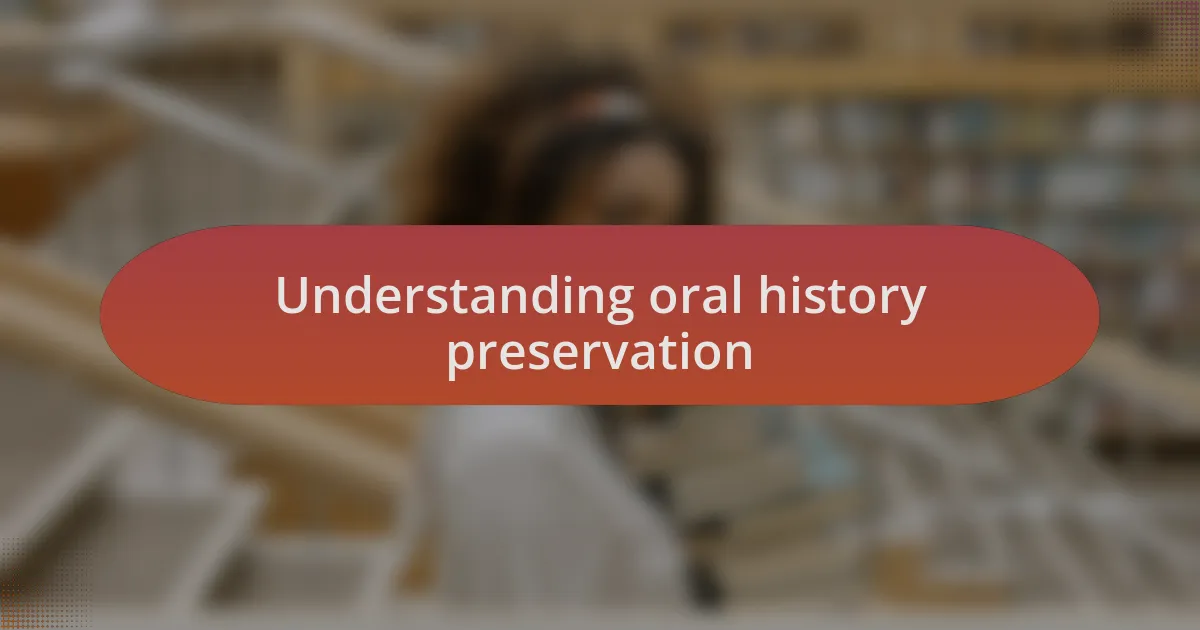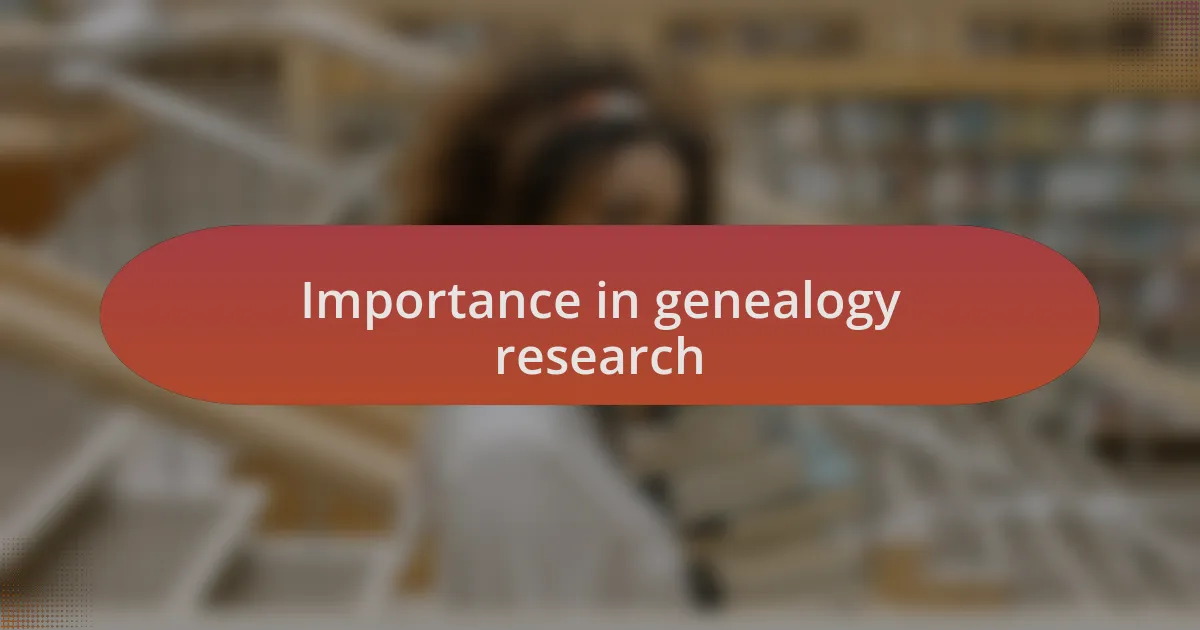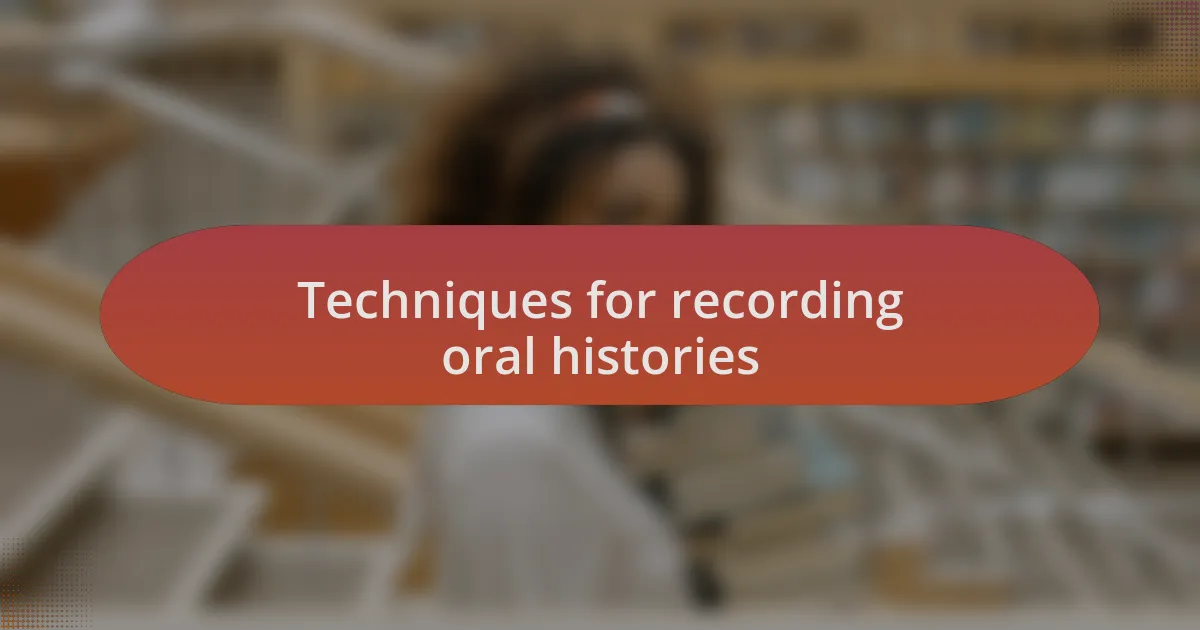Key takeaways:
- Oral history preservation captures lived experiences and personal narratives, enriching our understanding of the past.
- Effective techniques for recording include using audio, asking open-ended questions, and creating comfortable environments for storytelling.
- Transcription should focus on accuracy, capturing tone and emotion, and using clear formats for better accessibility.
- Sharing findings through storytelling and digital platforms enhances connections and engagement among family members.

Understanding oral history preservation
Oral history preservation is a fascinating practice that goes beyond just recording memories; it captures the very essence of lived experiences. I remember sitting with my grandmother, listening to her stories of growing up during the Great Depression. Her words were more than information; they were a window into a world I could never experience firsthand. How can we truly value our history if we don’t hold on to these personal narratives?
The process of preserving oral histories involves not just collecting stories but also understanding the context in which they were shared. For example, I once facilitated an oral history workshop in my community, where participants shared their migration stories. The emotions in those tales reminded me that each person’s journey weaves into a larger tapestry of cultural history. Why is it critical to preserve these accounts? Because they humanize the past, allowing us to connect more deeply with our ancestors.
Moreover, the digital age offers innovative ways to engage with oral histories. While digitizing recordings is essential, it’s equally important to approach these stories with respect and understanding. Listening to my friend’s family history on a digital platform moved me as if I were sitting right there in their living room. It raises a compelling question: can technology enhance the preservation of our stories while also honoring the voices behind them?

Importance in genealogy research
Genealogy research thrives on the stories passed down through generations. For instance, while compiling my family tree, I stumbled upon a long-forgotten tale about my great-aunt’s resilience during difficult times. This revelation not only enriched my research but also deepened my emotional connection to my family, highlighting how oral histories breathe life into stark census records and dusty archives.
The power of oral history lies in its ability to offer personal contexts that statistics alone cannot provide. When I interviewed my uncle about his experiences as an immigrant, he shared moments of joy, struggle, and hope that completely altered my understanding of our family’s past. These narratives transform genealogy from a list of names and dates into a rich tapestry of human emotions and experiences. How can we neglect the stories that give meaning to our family heritage?
Furthermore, oral histories often reveal connections to broader historical events through personal perspectives. I once heard a neighbor recount how his family was affected by a local disaster that shaped their community. His account not only added depth to my genealogy research but also illuminated the impact of history on individual lives. Isn’t it remarkable how one voice can encapsulate the struggles and triumphs of many? Engaging with these stories can truly enhance our understanding of who we are and where we come from.

Techniques for recording oral histories
When it comes to recording oral histories, I’ve found that choosing the right medium significantly affects the outcome. For instance, I prefer using audio recordings over video; audio often feels more intimate and allows for deeper emotional expressions. One time, while listening back to a recording of my grandmother recounting her childhood, I could almost feel her joy—it was as if I was sitting right next to her, sharing that moment.
Another technique I’ve embraced is focusing on open-ended questions during interviews. These prompts encourage storytellers to share richer, more detailed accounts. During a heartfelt conversation with my father about his military service, my question, “What was the most surprising experience you had?” led him to recount a vivid story of camaraderie that I had never heard before. Isn’t it astonishing how a simple question can unlock hidden treasures of our family history?
Finally, I cannot stress the importance of creating a comfortable environment. When I invited my great-uncle to share his memories in his own home, the familiarity of his surroundings helped to bring forth a wealth of stories. He spoke freely about his life experiences, enabling me to gather profound insights. How often do we forget that comfort can spur those cherished tales that connect us to our past?

Choosing the right interview subjects
Selecting the right interview subjects is crucial for capturing the essence of oral histories. I always seek individuals who have lived through significant events or possess unique life experiences. For instance, a few years back, I decided to interview a neighbor who survived a natural disaster in her youth. Her vivid recounting of that harrowing time not only highlighted her resilience but also gave me valuable insights into how communities come together during crises.
Another aspect to consider is the subject’s willingness to share. I once spoke with a distant relative who hesitated at first, recounting how painful it was to revisit certain memories. Listening to him express his fears made me realize that the emotional readiness of the subject can deeply influence the richness of the stories they share. How can we ensure that our chosen subjects are comfortable enough to open up and share their truths?
It’s also essential to think about the diversity of perspectives. I enjoy interviewing both older and younger family members to create a more comprehensive narrative. For example, when I gathered stories from my grandfather and my teenage cousin about the same family event, their differing interpretations showcased how perspectives can evolve over time. This richness can turn ordinary tales into a tapestry of experiences, making the oral history feel more vibrant and interconnected.

Best practices for transcription
Transcription is a vital step in preserving oral histories, and I’ve found that accuracy is paramount. When transcribing, I always strive to capture not just the words, but the tone and emotion behind them. Recently, while transcribing an interview with my grandmother, I noticed how her laughter and pauses added depth to her stories. How often do we overlook these nuances? By including them, we create a richer narrative that resonates with future readers.
Another best practice I’ve adopted is to use high-quality recording equipment. I’ve experienced firsthand the frustration of trying to decipher muffled words or background noise. Investing in a good microphone has made a world of difference in clarity. Sometimes, I even play back sections of the interview multiple times, ensuring I don’t miss any vital details. Have you ever noticed how a single word can change the entire context of a story? Every detail matters.
Finally, consider the format of your transcription. I prefer to use speaker labels and time stamps to keep track of different voices and key moments. This straightforward method not only organizes the content but also makes it easier for readers to navigate the material later. During one project, I found that timestamps helped me track shifts in my subject’s emotions, enhancing my understanding. Wouldn’t you agree that clarity in presentation can significantly impact how stories are received? Keeping these practices in mind can transform a simple transcription into a powerful historical document.

Sharing your oral history findings
When it comes to sharing your oral history findings, I’ve discovered that storytelling plays a crucial role. For instance, after gathering family stories from my uncle, I decided to present them at a family reunion. As I recounted his tales, I could see the spark in everyone’s eyes, and it reminded me how powerful these personal narratives can be when shared aloud. Have you ever noticed how certain stories can connect generations in a way that facts and dates never could?
In my experience, utilizing digital platforms for sharing is also essential. I once created a private online group where family members could listen to recorded interviews and read transcriptions. This not only engaged relatives far and wide but also allowed them to contribute their own memories, enriching the collective narrative. It’s amazing how technology can bridge gaps and foster family connections—have you thought about exploring this avenue?
Lastly, consider the importance of context when you share these stories. I remember feeling overwhelmed when I first shared my grandfather’s war stories without giving enough background on his experiences. By providing the historical context, I found that listeners were not only more engaged but also able to relate to his struggles on a personal level. How often do we forget that context adds layers of meaning? Taking the time to set the stage can truly transform how the stories resonate with your audience.